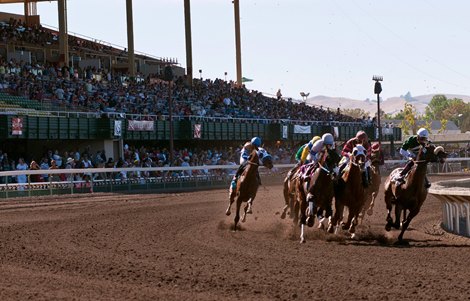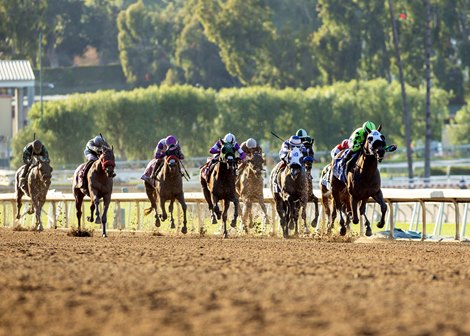Horse racing is unique in how quickly it can take you from the highest of highs to the lowest of lows, an experience on full display the weekend of June 7-9.
On the East Coast, celebrations broke out as Dornoch ‘s triumph in the Belmont Stakes (G1) capped a sensational racing festival weekend at one of the sport’s most historic venues, Saratoga Race Course. Meanwhile, on the West Coast, it was a scene of mourning as Adelie crossed the finish line in the last race ever to be held at another historic venue, Golden Gate Fields.
The Belmont was held at Saratoga due to the construction of a brand new Belmont Park, set to have all the looks and amenities of a world-class sporting venue—a peek at the bright future racing can have. Meanwhile, Golden Gate’s closure has thrown California racing into a deeper hole of uncertainty and chaos—a peek at the darker future racing can have.
The key to saving racing in the West could come from the source that has kept it afloat over the last decade: California breds.
“Cal-breds have gone from a nice compliment to racing to a necessity,” said California Thoroughbred Breeders Association president Doug Burge. “The importance of Cal-breds to California racing is vital.”
On the final weekend of racing in the San Francisco Bay area—whose racing roots go back to the mid-1800s—140 Thoroughbreds were entered over three days. Of those horses, 107 of them were California-bred, 76.4%. On June 8, 40 of the 45 entries were California-bred.
Racing at Golden Gate Fields
“Cal-breds are making up roughly 40% of the field sizes in the south, 70% or more in the north,” Burge said. “That’s why it’s so important that we have such a strong state-bred program.”
Burge believes industry stakeholders have created several creative incentives for California breeders and owners, and it appears they have responded. Despite the number of registered California-bred foals dropping from 3,823 in 2002 to 1,310 in 2022, the participation of those foals within California has increased.
According to The Jockey Club, as of June 1, 83% of California-bred foals from the 2002 crop competed in-state at least once while only making 56.2% of their career starts in California. For the foal crop of 2021, 90.5% have started in-state at least once while making 87.6% of starts in California.
In 2023, 2,984 Cal-breds started a total of 17,476 times, earning a total of $69,675,450 across the country—76.1% of which was earned in California.
“It’s been a collective buy-in between the CTBA, the Thoroughbred Owners of California, and the tracks to strengthen the program over the years,” Burge said.
Registered foals across North America have dropped from 35,978 in 2002 to about 18,700 in 2022. The country-wide decrease has been no help to California’s field size, which has dropped from an average of 7.6 in 2002 to 7.0 in 2023. As fewer horses are coming in from other states, it is the California-breds who are stabilizing the entry box in a state that has no subsidies from other types of gambling to aid purses.
“The Cal-bred program is so important with field sizes,” Burge said. “The handle on California-bred races—particularly when you have Cal-bred races that have field sizes of eight or above, which can be common—has a positive impact on all of California racing.”
The bonuses being offered to California owners and breeders help give a boost to purses that have fallen far behind those in states like Kentucky or Arkansas. These bonuses have helped to increase the average purse of races in California from $36,845 in 2002 to $56,496 in 2023.
The economic impact racing has had on the state of California has also seen large growth over the last five years in a state facing a large budget deficit.
According to an American Horse Council study earlier this year, the equine industry’s total value on California’s economy increased from $8.3 billion in 2018 to $11.6 billion in 2023, with direct impact on the state’s gross domestic product increasing from $4.5 billion to $6.5 billion.
Racing was cited as the greatest contributor from the equine industry, generating $2.5 billion and creating a direct GDP value of $1.5 billion. Racing—which includes Thoroughbreds, Quarter Horses, and Standardbreds—generated 24,860 jobs and supported a total of 36,980 in 2023.
AMERICAN HORSE COUNCIL: CA Horse Industry Sees Economic Growth Since 2018
“A large percentage of those jobs are at the farms,” Burge said. “They’re making a significant impact on the racing sector in the state.”
The announcement of Golden Gate’s closure was sudden last summer. Without much time to prepare, many owners, breeders, and other industry stakeholders voiced that they may leave the industry that has contributed so much to the state. However, that fear seems to have settled thanks to the creation of Golden State Racing, which in March received approval from the California Horse Racing Board to host extended meets at Pleasanton to fill in for Golden Gate.

Racing at Pleasanton
Official numbers for mares bred in California will not be available until August, but based on surveying farms, Burge believes the number of mares bred will not see as dramatic a drop as first expected.
“Going into the beginning of the year, everyone was worried about what the dip in the mares bred numbers would look like based on the closure of Golden Gate Fields,” he said. “Some farms have said they were down in the number of mares bred, but surprisingly a lot of the larger farms are breeding as much if not more than they were last year. I think the efforts of the northern California horsemen have brought some stability to the breeding sector.”
Ty Green, who breeds and races horses as SLO Racing, said he decided to increase the number of mares he bred to help fill the yearling market with the expected decrease, but it appears as though he was not the only one.
“Before the CHRB awarded the Golden State Racing, it seemed a lot of California breeders were either leaving their mares open or leaving breeding in California altogether,” Green said. “I bred all my mares thinking the yearling supply in 2026 would be lean. With Northern California now able to make a go of it, I’m going to have to rely on demand.”
Golden Gate appeared to be limping to the finish line as several race cards were canceled due to a lack of horses. However, this could largely be pointed at horsemen wanting to run elsewhere, like Turf Paradise in Arizona, thanks to purse cuts implemented for the entirety of Golden Gate’s final season.
Now that the California Association of Racing Fairs is taking over for the summer, and Golden State Racing right behind it, it appears Northern California horsemen are eager to return home to help support the new challenge. According to Green, who is also on the board of both the CTBA and TOC, Pleasanton has received about 1,000 stall applications, so many that Burge needs to bring in temporary stalls to host horses for the CTBA’s Northern California Yearling and Horses of Racing Age Sale Aug. 18.
Whether Northern California succeeds in a post-Golden Gate era is yet to be seen, as is the longevity of California racing with a lack of purse subsidies from other forms of gambling. However, the California-bred program is a bright spot for the state and will be an important factor in the racing’s survival.



)






